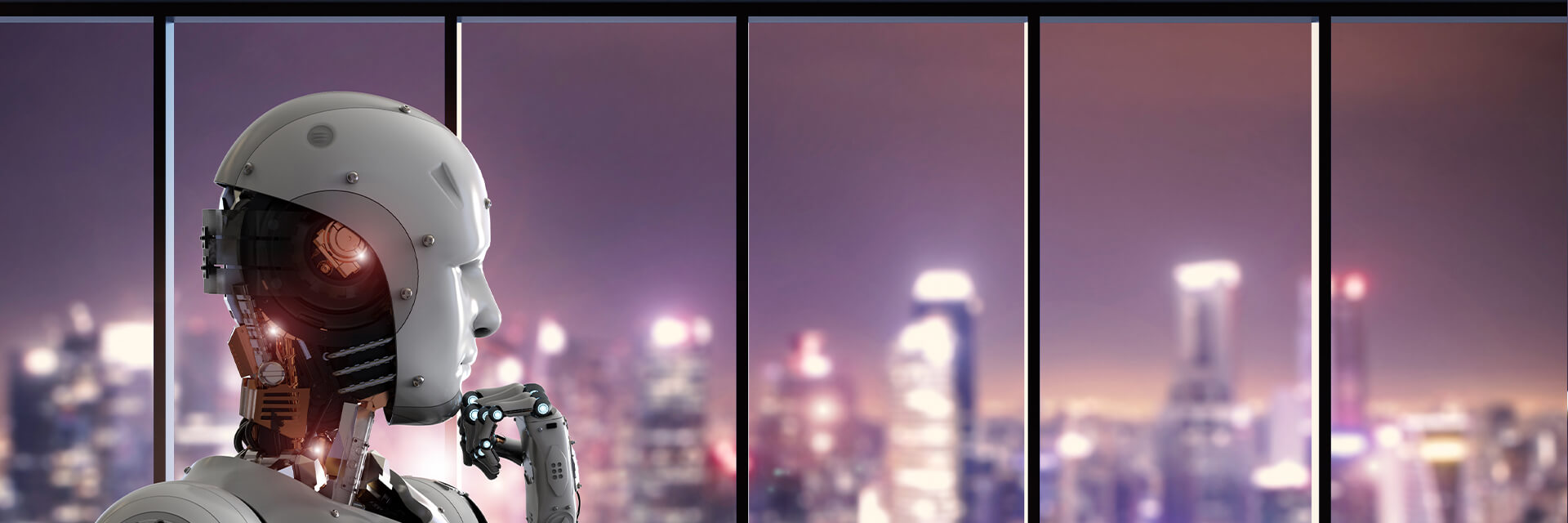
Artificial Intelligence in Robotics Process Automation (RPA)
- Published
- Jan 31, 2023
- Topics
- Share
Today, businesses are operating in a brand-new world, one where automation as a strategic priority is ever more conducive to business success. From being a mere concept to becoming prevalent among modern workplaces, robotics process automation (RPA) has come a long way. As leaders explore new avenues to push the limits of automation techniques, yet another trend is emerging. Through the powerful integration of RPA and artificial intelligence (AI), businesses are creating a transformative solution to streamline processes, simplify workflows, and ultimately improve customer experience.
What are RPA and AI?
RPA, also known as software robotics, is a technology that allows a developer to create computer software, or a “bot,” to emulate the actions of a human, integrating digital systems while executing a business process. These bots can utilize a user interface to capture data and manipulate applications just like humans do. They trigger responses, interpret results and communicate with other systems to perform a variety of repetitive tasks, never needing rest and making zero mistakes.
AI is the ability of a machine to display human-like cognitive capabilities such as reasoning, learning, planning and creativity. AI enables technical systems to perceive their environment, solve problems, respond intelligently to triggers and act accordingly to achieve specific goals. It can receive input from various sources, either externally or through sensors such as cameras. This input is processed and generates a response. To a certain degree, AI systems can adapt or change their behavior by analyzing the effects of previous actions and working autonomously.
Intelligent Automation (IA)
The integration of RPA and AI is referred to as intelligent automation (IA). IA encompasses 4 core technologies– RPA, AI, machine learning (ML), and natural language processing (NLP) to create smart business processes and workflows that think, learn and adapt on their own. At its core, it is a suite of business process improvements and next-generation tools that remove repetitive, replicable, and routine tasks, all while radically improving customer journeys by simplifying interactions and speeding up processes.
This integration expands the horizons of business process automation (BPA) and accelerates digital transformation.
Here are three ways in which AI and RPA can join forces to take business productivity to the next level:
RPA with NLP: This combination empowers users to read unstructured text, find the required information and convert it into a structured format for applications and processes to perform subsequent operations.
RPA with Deep Learning: When combined with deep learning, RPA can derive intelligence by performing automation on processes involving data in an electronic format. An application powered by RPA and deep learning can go into multiple layers of the data to transform it, detect any suspicious transactions and identify a potential fraud before it takes place. These efforts translate to significant cost savings for an organization.
RPA With ML: RPA does not have the capability to perform experiential learning on its own. The combination of RPA and ML enables the applications to learn from previous experiences while performing a particular process automation. The ML feature will allow RPA to analyze exceptions and build a model that accepts and rejects cases. This will increase the speed and accuracy of the automation without any human intervention.
Benefits of RPA and AI
- Reduce operational risks;
- Reduce data entry errors;
- Quick response time;
- Improved customer experience;
- Improved internal operation;
- Increase output;
- Better security;
- Scalability;
- Increase accuracy; and
- Improve analytical abilities.
Industries that Leverage IA
Health Care
For health care sectors, the efficiency and accuracy of every internal process are essentially crucial, as patients’ well-being and health depend on them. That’s why almost all hospitals and health care facilities use AI-based automation services to streamline data management, insurance processing, payment cycles, prescription management and other processes. With the implementation of AI bots, these automation tasks have much fewer errors and better patient experience.
Banking and Financial Services
The banking and financial sectors were one of the first industries to welcome the adoption of IA by leveraging AI. Currently, several prominent banks implement smart automation technologies to automate everything from anti-money laundering and customer services processing to account opening and know your customer (KYC) research. Sentient analysis-based chatbots and virtual assistants are widely used to help employees and customers quickly find answers to any type of question.
Insurance
Insurance is another industry that has several repetitive processes that are well-suited for artificial intelligence automation. Although insurance sectors have not adopted RPA as much as banking sectors, several use cases are already successfully automated in insurance. This comprises several application processing services, policy administration, regulatory compliance and much more.
Retail
Retail businesses are investing profoundly in automation to improve both customer and employee experiences. Popular applications of AI services in the retail industry include everything from fraud detection, warehouse management, online orders, customer assistance/support and customer relationship management. AI-based predictive analysis is also being widely adopted to determine customer trends and changing market demands. With predictive analysis and data analytics, retail businesses can significantly improve customer satisfaction and decrease wastage of products.
Human Resources (HR)
HR services include a tremendous amount of information management and standardization across different systems and domains, which makes them a good fit for intelligent automation. HR management has immense opportunities with artificial intelligence automation because the processes are mainly rule-based and demand a high degree of accuracy as well as speed.
Intelligent Automation in Action
IA possesses the cognitive ability to work with processes that contain unstructured data, making it a useful technology to tackle various use cases. By using transfer learning, IA leverages knowledge gained from modeled tasks to solve other related tasks. Here are five use cases where intelligent automation can be implemented:
- Invoice Processing Automation – Automating the processing of invoices is an exercise that presents challenges to virtually all large companies. They typically receive invoices from various vendors, which means that most of these invoices almost always contain unstructured content and are of various formats. Unfortunately, a regular expression or other rule-based tools that rely completely on templates are not well-suited to handle unstructured data. IA tools, on the other hand, can handle this type of content and more. IA uses Optical Character Recognition (OCR), ML and NLP to understand the context of a document, enabling it to identify and extract the information relevant to the process without having to create a template for every variation.
- Corporate Inbox Automation – In the corporate inbox use case, an intelligent automation tool processes incoming emails, deciphers the topic and then routes them to an appropriate subject expert. For relatively simple matters, such as a change of address request, the IA tool can extract the pertinent information and input it into an appropriate downstream system. An IA tool can also extract and automate the handling of any attachments from emails, such as PDFs, spreadsheets, or Microsoft Word documents. The IA tool is smart enough to process the attachments and extract relevant information and then input it into another downstream system, such as a customer relationship management (CRM) system, for processing or storage for future reference.
- Customer Onboarding – IA can be used to classify and extract relevant unstructured data from customer-onboarding documents into an organization’s digital management system. This results in improved accuracy and efficiency for onboarding new customers, driving improved customer satisfaction and increasing revenue for the company.
- Payroll Transactions – Processing payroll repetitively every month is a time-consuming and mundane task for an organization’s HR team, since it requires a significant amount of effort dedicated to data entry. Manual data entry often results in inaccuracies that can lead to delays in payment and unhappy employees. IA can reduce delays by checking the consistency of employee data across multiple systems and validating timesheets and deductions. IA can also automate salary formulating processes, manage benefits and payments and automate end-to-end payroll transactions to avoid inaccuracies and delays.
- Chatbots – One of the largest users of chatbots is online shopping portals. Customers have different preferences, distinct orders and product queries, etc., and implementing a chatbot serves to enhance their customers’ shopping experience and take care of mundane, repetitive tasks. While chatbots can provide relevant data, they may not be able to complete certain tasks unassisted. When integrated correctly, chatbots can feed data to an RPA bot to complete tasks like canceling an order or changing quantities or delivery dates based on certain criteria. This results in instant gratification to customers, enhancement of their shopping experience and reduction of burden on the overloaded customer service executives.
The Future of Automation: IA
Apart from the renowned near-zero error rates and significant cost reductions, optimization possibilities with IA are endless. Self-evolving processes can empower businesses with the much-needed agility to go beyond efficiency and adapt to change. When it comes to adopting IA in business, time is of the essence. Success will strongly favor those who accelerate adoption to remain competitive in their respective markets.
Key Takeaways
RPA and AI technology are both great tools to streamline BPA, but together they are a force to reckon with. When AI is integrated with RPA, it allows the automation process to begin much faster, creating an automation continuum.
A completely autonomous process would elicit a more cognitive response, transmitting it directly to the RPA system that would then complete the task. This automation continuum would result in even faster production. In terms of use cases, this could be as simple as reducing the wait-time on a customer inquiry issued during non-business hours.
According to Grand View Research, the global RPA market size was valued at $357.5 million in 2017 and is expected to register at a CAGR of 31.1% over the forecast period. Increasing demand for BPA using AI and software robots is anticipated to be the key growth-driving factor for the market.
The future of RPA and AI is glowing increasingly brighter, as more businesses continue to demand solutions that boost productivity and reduce cost. The technologies that continue to emerge from AI will soon bring on the complete automation continuum that many businesses are desperately searching for on a mission to exist as a front-runner in today’s fast-paced climate.
Conclusion
As shown in the use cases above, RPA combined with AI technologies offers a broad spectrum of use-cases and can result in significant savings in terms of cost and time when leveraged properly. A successful RPA implementation depends on choosing the right tools and processes for automation. In addition, a heavy focus on the process itself will lead to the most meaningful results. As companies’ RPA strategies continue to develop, the utilization of RPA integrated with AI capabilities will continue to grow and quickly become the industry standard.
Contact EisnerAmper
If you have any questions, we'd like to hear from you.
Receive the latest business insights, analysis, and perspectives from EisnerAmper professionals.










